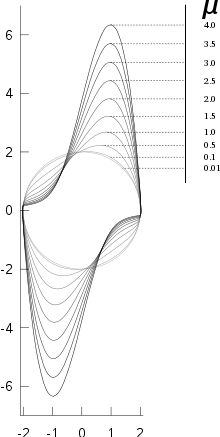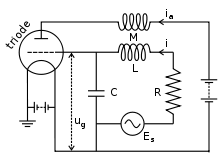Van der Pol oscillator


In dynamics, the Van der Pol oscillator is a non-conservative oscillator with non-linear damping. It evolves in time according to the second-order differential equation:
where x is the position coordinate—which is a function of the time t, and μ is a scalar parameter indicating the nonlinearity and the strength of the damping.
History
The Van der Pol oscillator was originally proposed by the Dutch electrical engineer and physicist Balthasar van der Pol while he was working at Philips.[1] Van der Pol found stable oscillations,[2] which he subsequently called relaxation-oscillations[3] and are now known as a type of limit cycle in electrical circuits employing vacuum tubes. When these circuits were driven near the limit cycle, they become entrained, i.e. the driving signal pulls the current along with it. Van der Pol and his colleague, van der Mark, reported in the September 1927 issue of Nature [4] that at certain drive frequencies an irregular noise was heard, which was later found to be the result of deterministic chaos.[5]
The Van der Pol equation has a long history of being used in both the physical and biological sciences. For instance, in biology, Fitzhugh[6] and Nagumo[7] extended the equation in a planar field as a model for action potentials of neurons. The equation has also been utilised in seismology to model the two plates in a geological fault,[8] and in studies of phonation to model the right and left vocal fold oscillators.[9]
Two-dimensional form
Liénard's theorem can be used to prove that the system has a limit cycle. Applying the Liénard transformation , where the dot indicates the time derivative, the Van der Pol oscillator can be written in its two-dimensional form:[10]
Another commonly used form based on the transformation leads to:
Results for the unforced oscillator
Two interesting regimes for the characteristics of the unforced oscillator are:[11]
- When μ = 0, i.e. there is no damping function, the equation becomes:
- This is a form of the simple harmonic oscillator, and there is always conservation of energy.
- When μ > 0, the system will enter a limit cycle. Near the origin x = dx/dt = 0, the system is unstable, and far from the origin, the system is damped.
- Van der Pol oscillator hasn’t an exact, analytic solution. Such solution for limit cycle exists if f(x) in Lienard equation is constant piece-wise function.
Hamiltonian for Van der Pol oscillator
One can also write a time-independent Hamiltonian formalism for the Van der Pol oscillator by augmenting it to a four-dimensional autonomous dynamical system using an auxiliary second-order nonlinear differential equation as follows:
Note that the dynamics of the original Van der Pol oscillator is not affected due to the one-way coupling between the time-evolutions of x and y variables. A Hamiltonian H for this system of equations can be shown to be [12]
where px and py are the conjugate momenta corresponding to x and y, respectively. This may, in principle, lead to quantization of the Van der Pol oscillator.
Forced Van der Pol oscillator
The forced, or driven, Van der Pol oscillator takes the 'original' function and adds a driving function Asin(ωt) to give a differential equation of the form:
where A is the amplitude, or displacement, of the wave function and ω is its angular velocity.
Popular culture

Author James Gleick described a vacuum-tube Van der Pol oscillator in his book Chaos: Making a New Science.[14] According to a New York Times article,[15] Gleick received a modern electronic Van der Pol oscillator from a reader in 1988.
See also
- Mary Cartwright, British mathematician, one of the first to study the theory of deterministic chaos, particularly as applied to this oscillator
References
- ↑ Cartwright, M.L., "Balthazar van der Pol", J. London Math. Soc., 35, 367-376, (1960).
- ↑ B. van de Pol: "A theory of the amplitude of free and forced triode vibrations", Radio Review (later Wireless World) 1 701-710 (1920)
- ↑ Van der Pol, B., "On relaxation-oscillations", The London, Edinburgh and Dublin Phil. Mag. & J. of Sci., 2(7), 978-992 (1926).
- ↑ Van der Pol, B. and Van der Mark, J., “Frequency demultiplication”, Nature, 120, 363-364, (1927).
- ↑ Kanamaru, T., "Van der Pol oscillator", Scholarpedia, 2(1), 2202, (2007).
- ↑ FitzHugh, R., “Impulses and physiological states in theoretical models of nerve membranes”, Biophysics J, 1, 445-466, (1961).
- ↑ Nagumo, J., Arimoto, S. and Yoshizawa, S. "An active pulse transmission line simulating nerve axon", Proc. IRE, 50, 2061-2070, (1962).
- ↑ Cartwright, J., Eguiluz, V., Hernandez-Garcia, E. and Piro, O., "Dynamics of elastic excitable media", Internat. J. Bifur. Chaos Appl. Sci. Engrg., 9, 2197–2202, (1999).
- ↑ Lucero, Jorge C.; Schoentgen, Jean (2013). "Modeling vocal fold asymmetries with coupled van der Pol oscillators". Proceedings of Meetings on Acoustics. 19 (1): 060165. ISSN 1939-800X. doi:10.1121/1.4798467.
- ↑ Kaplan, D. and Glass, L., Understanding Nonlinear Dynamics, Springer, 240–244, (1995).
- ↑ Grimshaw, R., Nonlinear ordinary differential equations, CRC Press, 153–163, (1993), ISBN 0-8493-8607-1.
- ↑ Shah, Tirth; Chattopadhyay, Rohitashwa; Vaidya, Kedar; Chakraborty, Sagar (2015). "Conservative perturbation theory for nonconservative systems". Physical Review E. 92 (6): 062927. Bibcode:2015PhRvE..92f2927S. doi:10.1103/physreve.92.062927.
- ↑ K. Tomita (1986): "Periodically forced nonlinear oscillators". In: Chaos, Ed. Arun V. Holden. Manchester University Press, ISBN 0719018110, pp. 213–214.
- ↑ Gleick, James (1987). Chaos: Making a New Science. New York: Penguin Books. pp. 41–43. ISBN 0-14-009250-1.
- ↑ Colman, David (11 July 2011). "There's No Quiet Without Noise". New York Times. Retrieved 11 July 2011.
External links
- Hazewinkel, Michiel, ed. (2001) [1994], "Van der Pol equation", Encyclopedia of Mathematics, Springer Science+Business Media B.V. / Kluwer Academic Publishers, ISBN 978-1-55608-010-4
- Van der Pol oscillator on Scholarpedia
- Van Der Pol Oscillator Interactive Demonstrations

